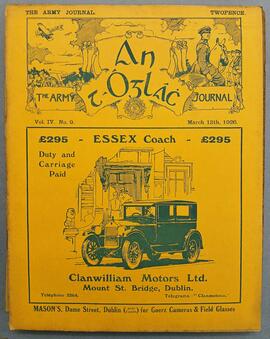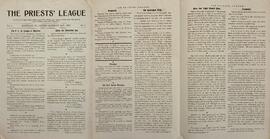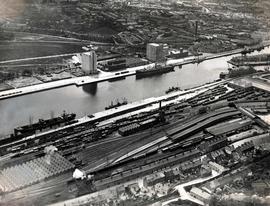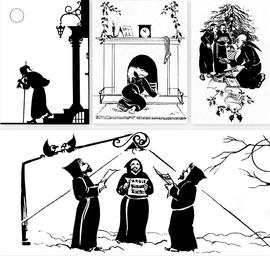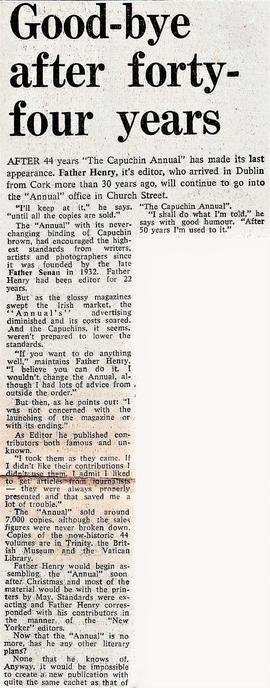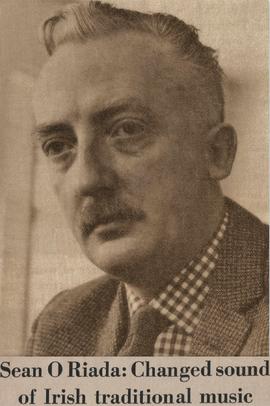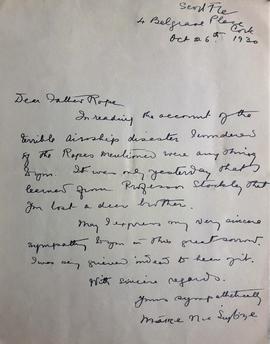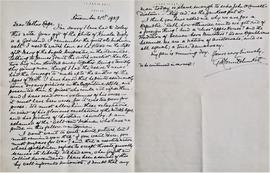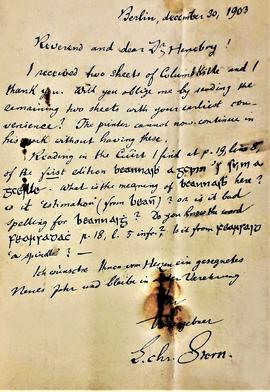A file of editions of ‘An t-Óglách / The Army Journal’ from January 1926 to December 1926. Some of the issues include articles assessing the 1916 Rising.
A copy of a flier titled the ‘Priests’ League’ (Vol. 1, No. 1, 1908). The flier was printed issued in Scottdale, Pennsylvania, and was most likely issued by a local branch of the Catholic Total Abstinence Union of America.
A file of letters from Cardinal Ercole Consalvi, a senior official in the Roman Curia. All the letters are written from Rome. One letter is dated 6 September 1801 with the remaining four seemingly dating from May to August 1817. The letters are unsigned and a few may be incomplete. With a covering envelope annotated ‘Consalvi’.
Photographic prints submitted for publication in 'The Capuchin Annual'. The file includes prints of Irish cities and towns. Many of the prints are annotated on the reverse. The file includes the following images:
• Port of Cork.
• St. Patrick’s Street, Cork.
• Grand Parade, Cork.
• South Mall, Cork.
• O’Connell Street, Dublin.
• Father Mathew Bridge, Dublin.
• River Barrow, Crom-a-Boo Bridge and White’s Castle, Athy, County Kildare.
• Cromwell’s Arch, Youghal, County Cork.
• Galway City Docks.
• Cork City docks.
• The Lord Mayor of Cork ‘throwing the dart’ to define the boundaries and jurisdiction of Cork Harbour.
• Royal Dublin Society, Ballsbridge, Dublin.
• St. Patrick’s Cathedral, Armagh.
• Penrose Quay, Cork.
• View of Clonmel, County Tipperary, from Convent Bridge with St. Mary’s Church in the foreground.
• Four Courts, Dublin.
• Cavendish Row and Parnell Street, Dublin.
• Leinster Market, Dublin.
• Shandon Tower, Cork City.
• City Hall, Cork.
• St. Patrick’s Hill, Cork.
• Gurranabraher, Cork.
• Entrance to the Ford vehicle plant, Cork.
• The Loopline Bridge, Dublin.
• Main Street, Clifden, County Galway.
• Holycross Cottages, Holycross, County Tipperary.
• Merrion Square East, Dublin.
• The Ha’penny Bridge, Dublin.
• Riverfront, Wexford.
• Boyne Viaduct, Drogheda, County Louth.
• Kilkenny City.
• The ship Innisfallen at Penrose Quay, Cork.
• Falls Road, Belfast.
• Ballina, County Mayo.
• Athlone, County Westmeath.
• Derry City, County Londonderry.
• Sarsfield Bridge over the River Shannon, Limerick City.
• The Band Hollow, Phoenix Park, Dublin.
• Cavendish Row, Dublin.
• Haulbowline, Cork Harbour.
• Shop front, MacCurtain Street, Cork.
• St. Stephen’s Green, Dublin.
• Dalkey Island viewed from Killiney Hill, County Dublin.
• Dun Laoghaire Harbour.
• Two religious sisters in the Phoenix Park, Dublin.
• School on Cove Street, Cork.
• Mill and malting buildings, Prospect Row, Cork.
• Cobh, County Cork.
• Dún Laoghaire harbour, County Dublin.
• The Custom House, Dublin.
• The Mills at Dublin Port.
• Victoria Quay, Dublin.
• Sunday's Well, Cork.
• National Monument, Grand Parade, Cork.
• Cork Marina and the River Lee as seen from Montenotte.
• Fishing on the banks of the River Liffey, near Chapelizod, Dublin.
• The Gresham Hotel, O’Connell Street, Dublin.
• Changing of army guards at Leinster House, Dublin
File containing illustrations for 'The Capuchin Annual' by Fr. Gerald McCann OFM Cap. (1910-1958). These humorous black-ink drawings depict aspects of Capuchin Franciscan life and were regularly published in the 'Annual'. Fr. Gerald also served as assistant-editor of the publication. The themes include Christmas festivities, pranks and mischiefs involving Capuchins (some of the friars depicted, including Fr. Senan Moynihan OFM Cap., were known to Fr. Gerald), sports, music, everyday chores and religious rituals.
Newspaper clippings of reviews of various editions of 'The Capuchin Annual'. The file includes articles from the 'Cork Examiner', 'Irish Catholic', 'Dublin Opinion', 'Evening Mail', 'Irish News', 'Irish Press', 'The Advocate', 'The Leader', 'Irish Independent', 'Sunday Independent', 'The Corkman', 'The Kerryman', 'Catholic Standard', 'Limerick Leader', 'Connaught Tribune', 'Wexford People', and 'The Electrical Mail; (a publication issued by ESB). The file also includes typescript reviews of the 'Annual' in broadcasts by Radio Éireann in 1961-2. Specific topics and reviews include features on the 1916 Rising (the 1966 edition of the 'Annual'), the Gaelic Athletic Association, Francis Ledwidge, Archbishop Daniel Mannix, and various photographic features in the 'Annuals'. An article by Desmond Rushe in the 'Irish Independent' (6 Jan. 1977) expresses regret that the 'Annual' will cease publication.
Clippings from the 'Irish Times' (4-6 Oct. 1971) referring to the death and funeral of the Irish composer, Seán Ó Riada (d. 3 Oct. 1971).
Letters from Mary MacSwiney (Máire Nic Shuibhne, 1872-1942) to Fr. Henry Rope. Two of the letters are copies (Rope notes that the copies were made in 1947 and that he deposited the originals in the archives of the Pontifical Irish College in Rome). One of the copy letters (dated 21 Nov. 1922) refers to Mary MacSwiney’s treatment by the Free State authorities. It reads ‘The hardest part of my trial here is being deprived of the Sacraments as I have not succeeded in finding a priest who will be satisfied to hear the confession of my sins and let my political convictions alone’. The original letter (26 Oct. 1930) refers to the ‘terrible airship disaster’ involving R 101, a British rigid airship. The disaster claimed the lives of forty-eight of the fifty-four people on board including Fr. Henry Rope’s younger brother, Squadron Leader Frederick Michael Rope.
Letters from George Noble Plunkett (1851-1948), 40 Elgin Road, Dublin, to Fr. Henry Rope. The letters include references to Plunkett’s desire to establish an ‘Academy of Christian Art’ in Dublin, Catholic literature, Father Rope’s visits to the Plunkett residence, and to contemporary political matters and public affairs in both Britain and Ireland. A recurring theme in the correspondence is Plunkett’s continuing republican opposition to the post-Treaty settlement in Ireland. An extract from a letter
written on 21 November 1929 reads:
‘I don’t want to write about politics, but I remind you that “if you want peace, you must prepare for war”; and, that a resolute nation, whose spokesmen refuse to accept threats, generally secures its liberty. We had won, when [Arthur] Griffith and [Michael] Collins surrendered: I have been assured of this by well informed unionists. I doubt that any man today is slave enough to echo John O’Connell’s dictum. “Nuff ced”, as the Yankees put it.
I think you asked me why we are for a Republic. Well, how otherwise could we get rid of a foreign King? And a “class” Upper House”? And the tradition of Heaven-born Ministers? We are republicans because we are a nation of aristocrats, and so all equal; a true democracy.
My pen is running dry.
Yours very sincerely,
G.N. Count Plunkett
To be continued in our next’.
The file also includes some letters from George Noble Plunkett’s wife (Josephine Plunkett née Cranny), and daughter Mary Plunkett. The letter from Mary Plunkett refers to the death of Count Plunkett. It reads ‘The poor old man was in bed for more than three years. We expected that he would go very quickly. Instead of that he was dying for twelve days. The poor old body was worn out, but that strong valiant spirit held on. He suffered a lot, so much that we prayed that God would take him. The end was very quiet’. (5 May 1948). A letter to Fr. Senan Moynihan from Fr. Henry Rope in this file refers to his donation of Plunkett's correspondence ‘for your Archives, which may also one day be of historical interest’. He also notes that he has given some of his correspondence with Count Plunkett to Saint Isidore’s College in Rome. (20 Dec. 1951)
Letter from Ludwig Christian Stern to Fr. Richard Henebry enclosing printed extracts from the latter’s ‘Life of Colum Cille’.
